2010 INFINITI QX56 upper
[x] Cancel search: upperPage 3201 of 4210

RSU-14
< REMOVAL AND INSTALLATION >
REAR SUSPENSION MEMBER
• When installing the upper and lower rubber seats for the rear coilsprings, the arrow embossed on the rubber seats must point out
toward the wheel and tire assembly.
• To connect the rear load leveling air suspension hoses, the lock ring must be fully seated in the fitt ing. Insert the hose (B) into the
lock ring (A) until the lock ring (A) is touching the hose (B) as
shown. Pull on the hose to check that it is securely inserted.
• Perform the final tightening of the nuts and bolts for the links (rubber bushing) under unladen condition (unladen condition means that the fuel tank, engine cool ant and lubricants are at the full specification, and
the spare tire, jack, hand tools, and mats are in t heir designated positions) with the tires on level ground.
• Check the wheel alignment. Refer to RSU-6, "
Wheel Alignment Inspection" .
LEIA0076E
LEIA0078E
Revision: April 20092010 QX56
Page 3202 of 4210
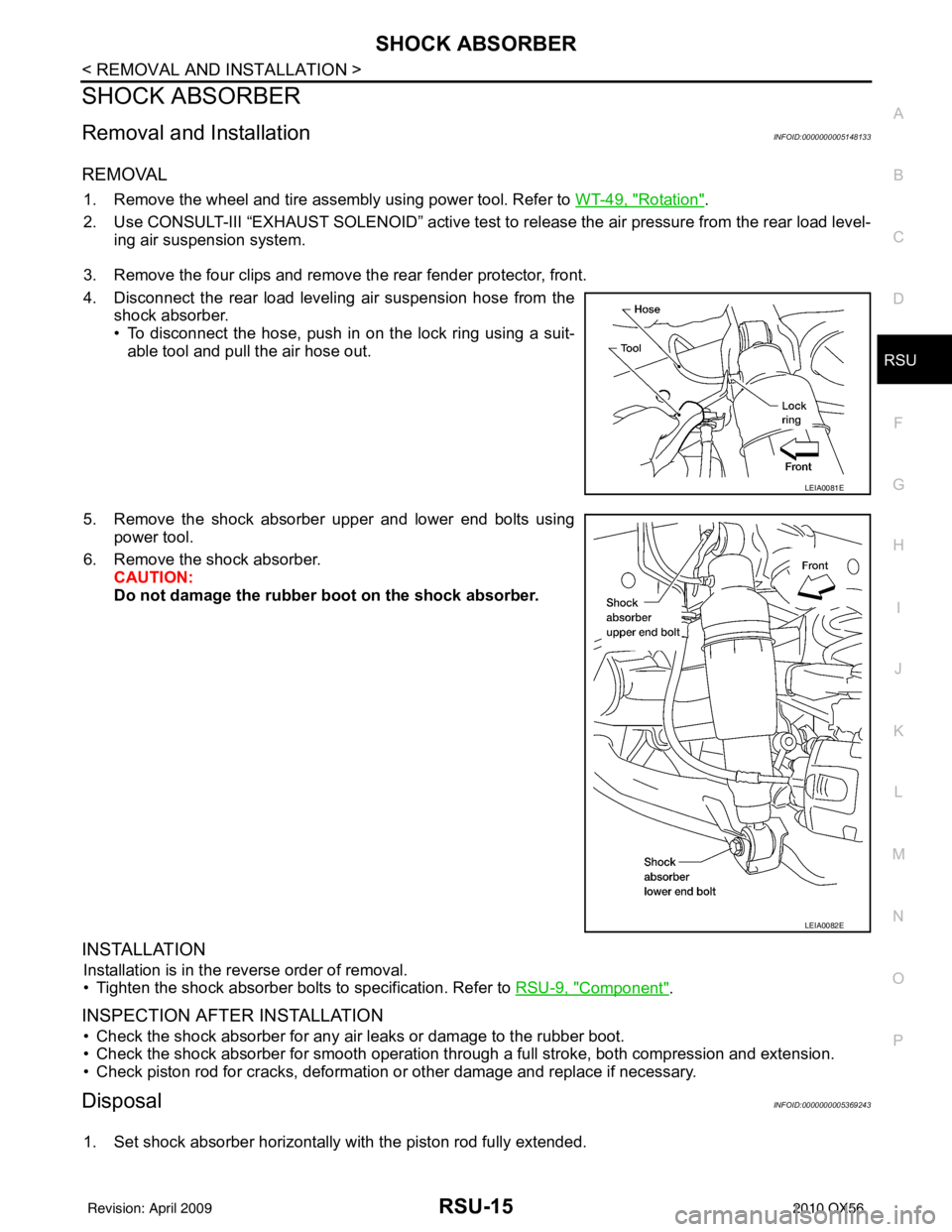
SHOCK ABSORBERRSU-15
< REMOVAL AND INSTALLATION >
C
DF
G H
I
J
K L
M A
B
RSU
N
O P
SHOCK ABSORBER
Removal and InstallationINFOID:0000000005148133
REMOVAL
1. Remove the wheel and tire assembly using power tool. Refer to WT-49, "Rotation".
2. Use CONSULT-III “EXHAUST SOLENOID ” active test to release the air pressure from the rear load level-
ing air suspension system.
3. Remove the four clips and remove the rear fender protector, front.
4. Disconnect the rear load leveling air suspension hose from the shock absorber.
• To disconnect the hose, push in on the lock ring using a suit-
able tool and pull the air hose out.
5. Remove the shock absorber upper and lower end bolts using power tool.
6. Remove the shock absorber. CAUTION:
Do not damage the rubber boot on the shock absorber.
INSTALLATION
Installation is in the reverse order of removal.
• Tighten the shock absorber bolts to specification. Refer to RSU-9, "
Component".
INSPECTION AFTER INSTALLATION
• Check the shock absorber for any air leaks or damage to the rubber boot.
• Check the shock absorber for smooth operation through a full stroke, both compression and extension.
• Check piston rod for cracks, deformation or other damage and replace if necessary.
DisposalINFOID:0000000005369243
1. Set shock absorber horizontally with the piston rod fully extended.
LEIA0081E
LEIA0082E
Revision: April 20092010 QX56
Page 3204 of 4210
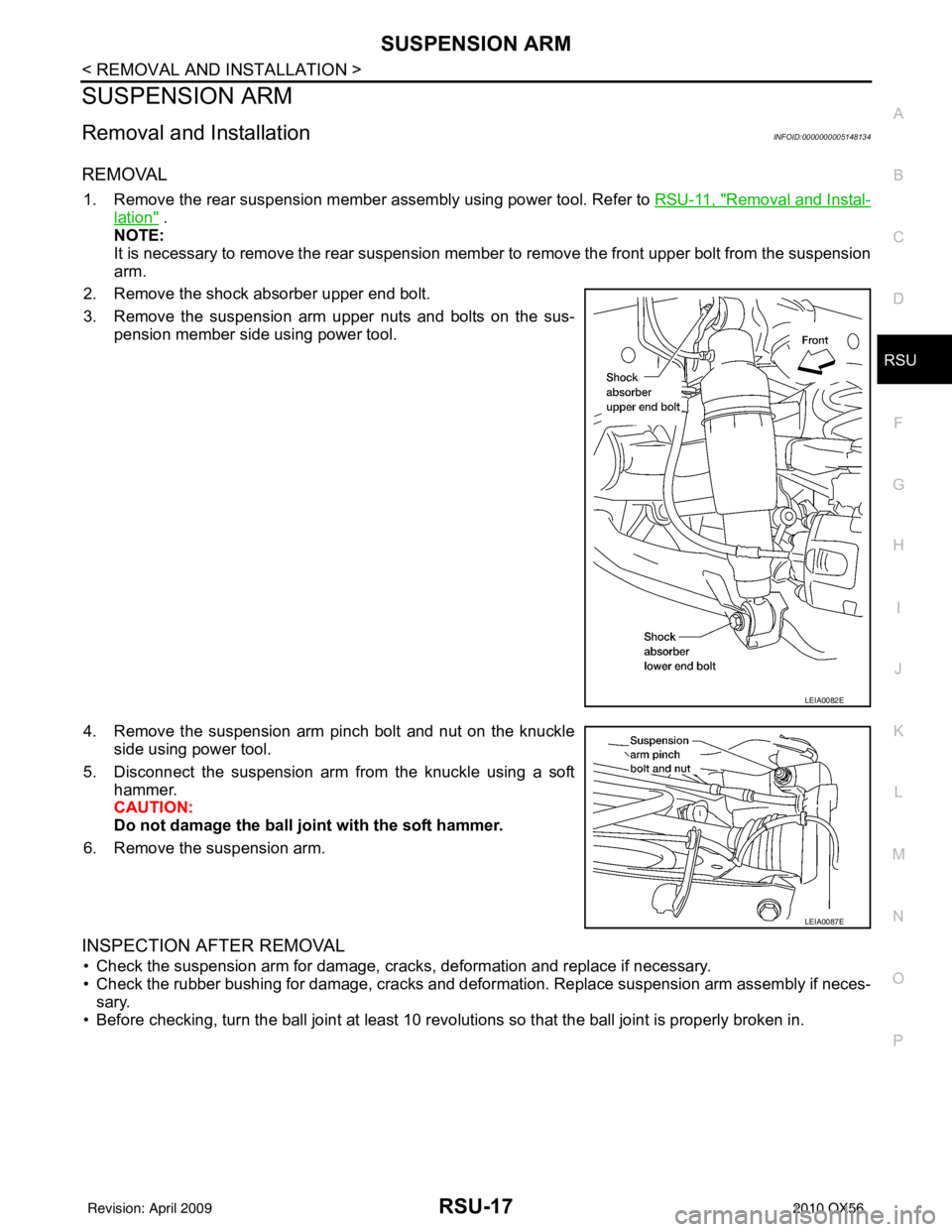
SUSPENSION ARMRSU-17
< REMOVAL AND INSTALLATION >
C
DF
G H
I
J
K L
M A
B
RSU
N
O P
SUSPENSION ARM
Removal and InstallationINFOID:0000000005148134
REMOVAL
1. Remove the rear suspension member assembly using power tool. Refer to RSU-11, "Removal and Instal-
lation" .
NOTE:
It is necessary to remove the rear suspension member to remove the front upper bolt from the suspension
arm.
2. Remove the shock absorber upper end bolt.
3. Remove the suspension arm upper nuts and bolts on the sus- pension member side using power tool.
4. Remove the suspension arm pinch bolt and nut on the knuckle side using power tool.
5. Disconnect the suspension arm from the knuckle using a soft hammer.
CAUTION:
Do not damage the ball joint with the soft hammer.
6. Remove the suspension arm.
INSPECTION AFTER REMOVAL
• Check the suspension arm for damage, cracks, deformation and replace if necessary.
• Check the rubber bushing for damage, cracks and deformati on. Replace suspension arm assembly if neces-
sary.
• Before checking, turn the ball joint at least 10 revo lutions so that the ball joint is properly broken in.
LEIA0082E
LEIA0087E
Revision: April 20092010 QX56
Page 3208 of 4210
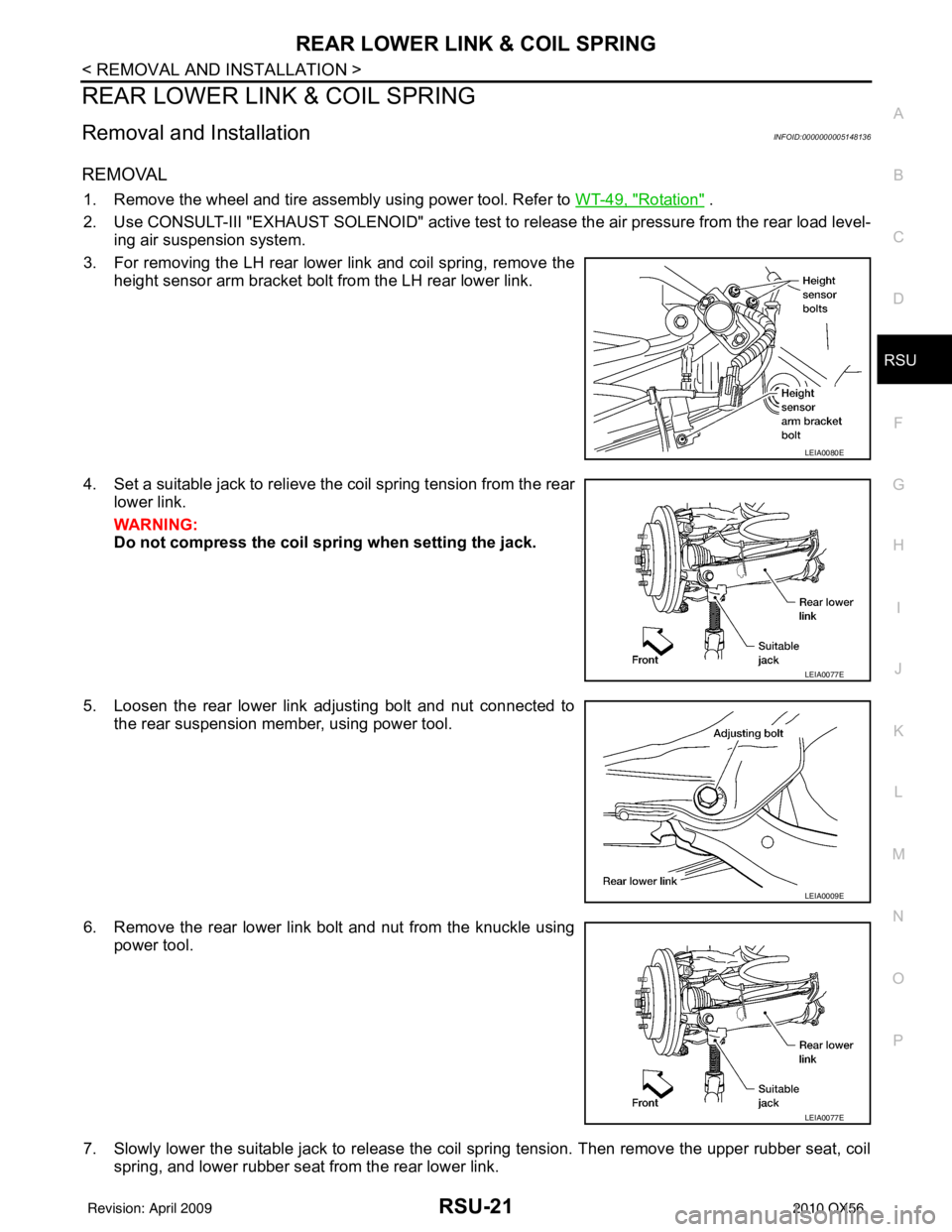
REAR LOWER LINK & COIL SPRINGRSU-21
< REMOVAL AND INSTALLATION >
C
DF
G H
I
J
K L
M A
B
RSU
N
O P
REAR LOWER LINK & COIL SPRING
Removal and InstallationINFOID:0000000005148136
REMOVAL
1. Remove the wheel and tire assembly using power tool. Refer to WT-49, "Rotation" .
2. Use CONSULT-III "EXHAUST SOLENOID" active test to release the air pressure from the rear load level-
ing air suspension system.
3. For removing the LH rear lower link and coil spring, remove the height sensor arm bracket bolt from the LH rear lower link.
4. Set a suitable jack to relieve the coil spring tension from the rear lower link.
WARNING:
Do not compress the coil sp ring when setting the jack.
5. Loosen the rear lower link adjusting bolt and nut connected to the rear suspension member, using power tool.
6. Remove the rear lower link bolt and nut from the knuckle using power tool.
7. Slowly lower the suitable jack to release the coil spring tension. Then remove the upper rubber seat, coil spring, and lower rubber seat from the rear lower link.
LEIA0080E
LEIA0077E
LEIA0009E
LEIA0077E
Revision: April 20092010 QX56
Page 3209 of 4210
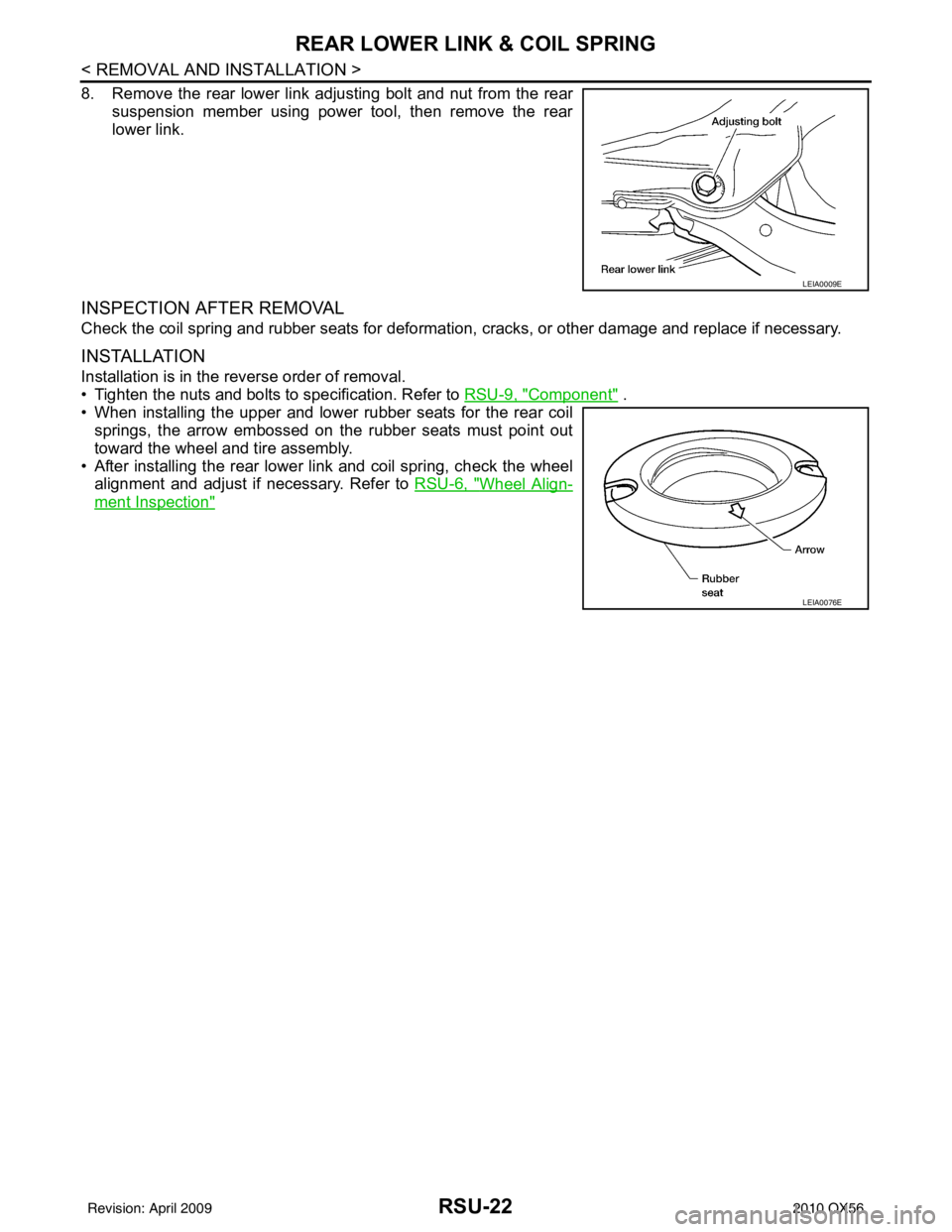
RSU-22
< REMOVAL AND INSTALLATION >
REAR LOWER LINK & COIL SPRING
8. Remove the rear lower link adjusting bolt and nut from the rearsuspension member using power tool, then remove the rear
lower link.
INSPECTION AFTER REMOVAL
Check the coil spring and rubber seats for deformation, cracks, or other damage and replace if necessary.
INSTALLATION
Installation is in the reverse order of removal.
• Tighten the nuts and bolts to specification. Refer to RSU-9, "
Component" .
• When installing the upper and lower rubber seats for the rear coil springs, the arrow embossed on the rubber seats must point out
toward the wheel and tire assembly.
• After installing the rear lower link and coil spring, check the wheel alignment and adjust if necessary. Refer to RSU-6, "
Wheel Align-
ment Inspection"
LEIA0009E
LEIA0076E
Revision: April 20092010 QX56
Page 3221 of 4210
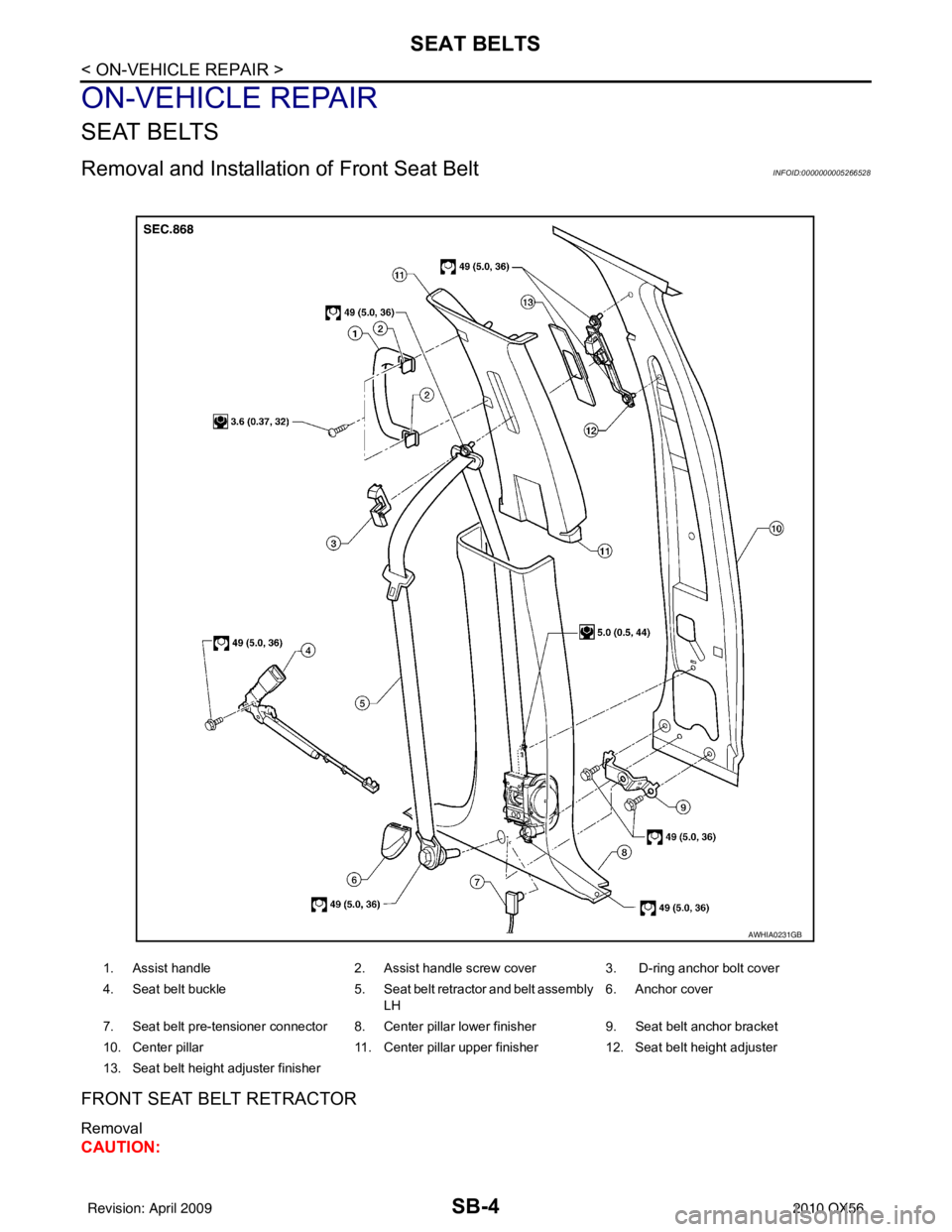
SB-4
< ON-VEHICLE REPAIR >
SEAT BELTS
ON-VEHICLE REPAIR
SEAT BELTS
Removal and Installation of Front Seat BeltINFOID:0000000005266528
FRONT SEAT BELT RETRACTOR
Removal
CAUTION:
1. Assist handle 2. Assist handle screw cover3. D-ring anchor bolt cover
4. Seat belt buckle 5. Seat belt retractor and belt assembly
LH 6. Anchor cover
7. Seat belt pre-tensioner connector 8. Center pillar lower finisher 9. Seat belt anchor bracket
10. Center pillar 11. Center pillar upper finisher12. Seat belt height adjuster
13. Seat belt height adjuster finisher
AWHIA0231GB
Revision: April 20092010 QX56
Page 3222 of 4210
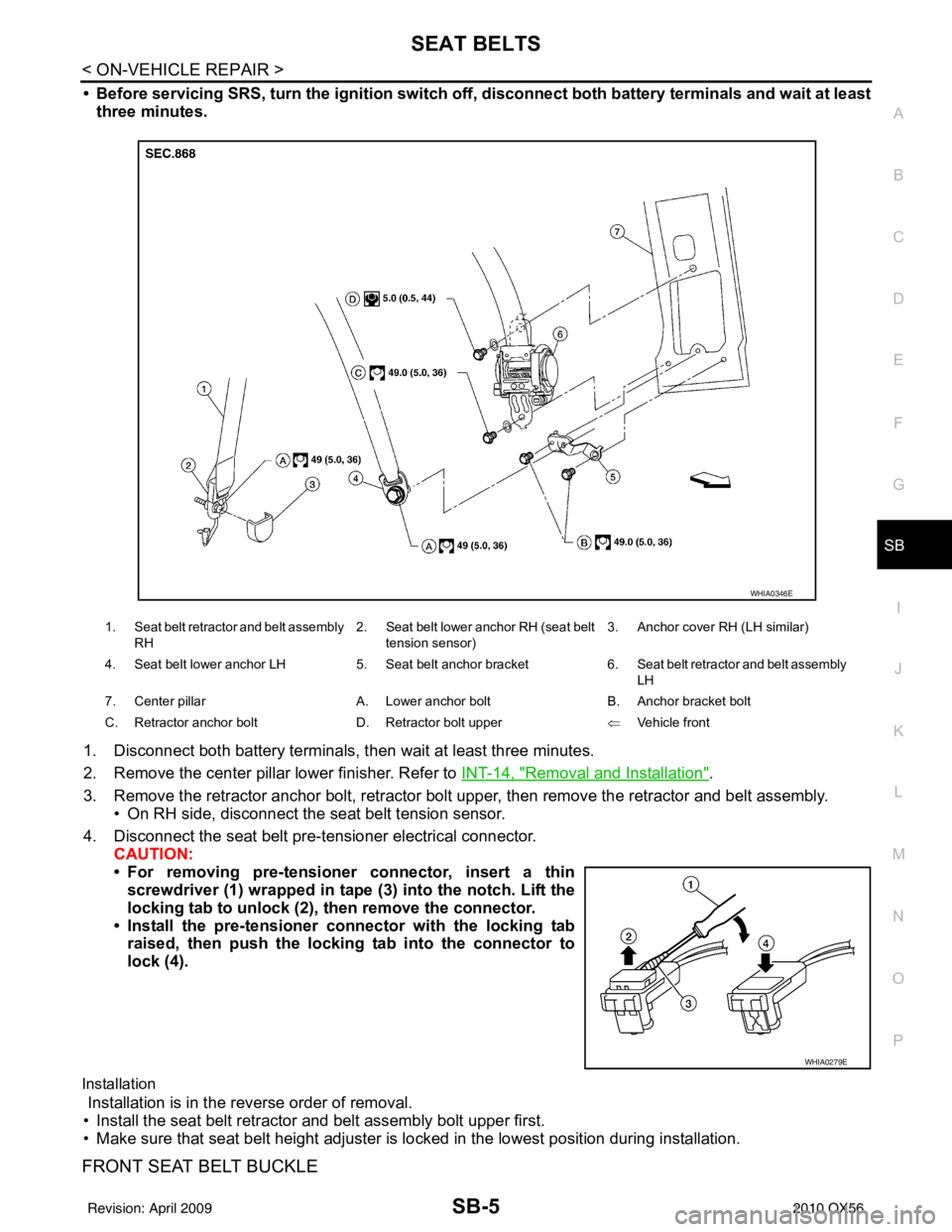
SEAT BELTSSB-5
< ON-VEHICLE REPAIR >
C
DE
F
G
I
J
K L
M A
B
SB
N
O P
• Before servicing SRS, turn the igni tion switch off, disconnect both battery terminals and wait at least
three minutes.
1. Disconnect both battery terminals, t hen wait at least three minutes.
2. Remove the center pillar lower finisher. Refer to INT-14, "
Removal and Installation".
3. Remove the retractor anchor bolt, retractor bolt upper, then remove the retractor and belt assembly. • On RH side, disconnect the seat belt tension sensor.
4. Disconnect the seat belt pre-tensioner electrical connector. CAUTION:
• For removing pre-tensioner connector, insert a thinscrewdriver (1) wrapped in tape (3) into the notch. Lift the
locking tab to unlock (2), then remove the connector.
• Install the pre-tensioner co nnector with the locking tab
raised, then push the locking tab into the connector to
lock (4).
Installation
Installation is in the reverse order of removal.
• Install the seat belt retractor and belt assembly bolt upper first.
• Make sure that seat belt height adjuster is lo cked in the lowest position during installation.
FRONT SEAT BELT BUCKLE
1. Seat belt retractor and belt assembly
RH 2. Seat belt lower anchor RH (seat belt
tension sensor) 3. Anchor cover RH (LH similar)
4. Seat belt lower anchor LH 5. Seat belt anchor bracket6. Seat belt retractor and belt assembly
LH
7. Center pillar A. Lower anchor boltB. Anchor bracket bolt
C. Retractor anchor bolt D. Retractor bolt upper ⇐Vehicle front
WHIA0346E
WHIA0279E
Revision: April 20092010 QX56
Page 3229 of 4210

SB-12
< ON-VEHICLE REPAIR >
SEAT BELTS
4. Check the shoulder seat belt guide and shoulder belt height adjuster for\
front seats. Ensure guide swivelsfreely and that belt lays flat and does not bind in guide. Ensure height adjuster operates properly and
holds securely.
5. Check retractor operation:
a. Fully extend the seat belt webbing and check for twists, tears or other damage.
b. Allow the seat belt to retract. Ensure that belt retu rns smoothly and completely into the retractor. If the
seat belt does not return smoothly, wipe the inside of the loops with a clean paper cloth, because dirt built
up in the loops of the upper anchors can c ause the seat belts to retract slowly.
c. Fasten the seat belt. Check the seat belt returns smoothly and completely to the retractor. If the belt does not return smoothly, the cause may be an accumulati on of dust or dirt. Use the “SEAT BELT TAPE SET”
and perform the following steps.
Inspect the front seat belt through-anchor:1. Pull the seat belt out to a length of 500 mm (19.69 in) or more.
2. Use a clip or other device to hold the seat belt at the center pillar belt opening.
3. Pass a thin wire through the through-anchor belt opening. Hold both ends of the wire and pull taut while moving it up and down several times along the belt opening surface to remove dirt.
4. Any dirt that cannot be removed with the wir e can be removed by cleaning the opening with a clean
cloth.
5. Apply tape at the point where the belt contacts the through-anchor belt opening.
NOTE:
Apply the tape so that there is no looseness or wrinkling.
6. Remove the clip holding the seat belt and check that the belt returns smoothly.
7. Repeat steps above as necessary to check the other seat belts.
SEAT BELT RETRACTOR ON-VEHICLE CHECK
Emergency Locking Retractors (ELR) and Automatic Locking Retractors (ALR)
NOTE:
All seat belt retractors are of the Emergency Locking Retractors (ELR) type. In an emergency (sudden stop)
the retractor will lock and prevent the belt from ext ending any further. All 3-point type seat belt retractors
except the driver's seat belt also have an Automati c Locking Retractors (ALR) mode. The ALR mode (also
called child restraint mode) is used when installing child seats. The ALR mode is activated when the seat belt
is fully extended. When the belt is then retracted partiall y, the ALR mode automatically locks the seat belt in a
specific position so the belt cannot be extended any furt her. To cancel the ALR mode, allow the seat belt to
fully wind back into the retractor.
Check the seat belt retractors using the following test(s ) to determine if a retractor assembly is operating prop-
erly.
ELR Function Stationary Check
Grasp the shoulder belt and pull forward quickly. The re tractor should lock and prevent the belt from extending
further.
ALR Function Stationary Check
1. Pull out entire length of seat belt from retractor until a click is heard.
2. Retract the belt partially. A clicking noise should be hear d as the belt retracts indicating that the retractor is
in the Automatic Locking Retractor (ALR) mode.
3. Grasp the seat belt and try to pull out the retractor. The belt must lock and not extend any further. If neces-
sary replace the retractor assembly.
4. Allow the entire length of the belt to re tract to cancel the automatic locking mode.
ELR Function Moving Check
WARNING:
Perform the following test in a safe, open area clear of other vehicles and obstructions (for example, a
large, empty parking lot). Road surface must be p aved and dry. DO NOT perform the following test on
wet or gravel roads or on public streets and highw ays. This could result in an accident and serious
personal injury. The driver and passenger must be prepared to brace themselves in the event the
retractor does not lock.
1. Fasten drivers seat belt. Buckle a passenger in to the seat for the belt that is to be tested.
Revision: April 20092010 QX56